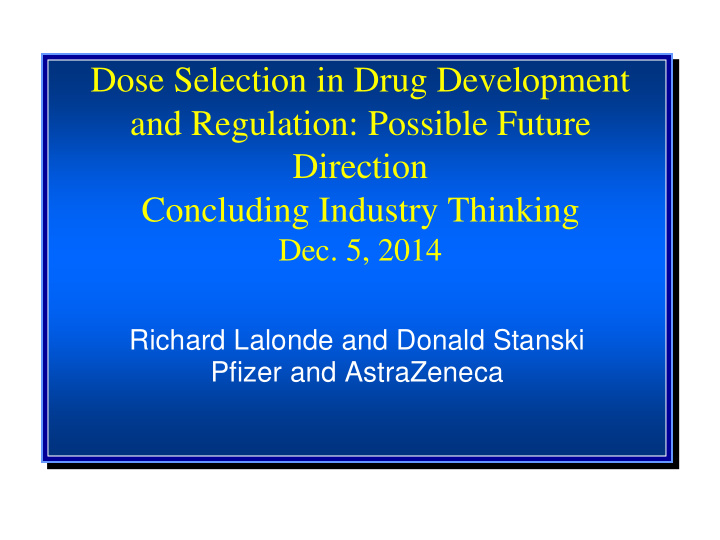



Dose Selection in Drug Development and Regulation: Possible Future Direction Concluding Industry Thinking Dec. 5, 2014 Richard Lalonde and Donald Stanski Pfizer and AstraZeneca
Concluding thinking: What have we learned from this meeting? What is the “elephant in the room”? Possible ways to move forward. 2 EMA 2014
What have we learned in this meeting? Much learning, an excellent meeting of content The 20 year old ICH E4 guidance does discuss Dose vs. Response, same with FDA documents Regulators care about Dose Response as much as industry!! The regulatory legal approval bar is risk vs. benefit, not dose The body of science to establish dose vs. response is well established and rich, many excellent examples and methodologies for most therapeutic areas The targets and diseases are harder 3 EMA 2014
Jose Pinherio and our key points: ● Selection of dose for Phase 3 is an estimation problem and should not be addressed via hypothesis testing ● Model-based dose finding methods are more efficient than pairwise comparisons approaches ● Wider dose/exposure ranges (> 10 fold) and larger number of doses/regimens (> 3) should be routinely used in Phase 2 ● Adaptive dose-ranging approaches, when feasible, can lead to substantial efficiency gains (time, number of patients, etc.) ● Longitude data analysis (time vs drug effect) is extremely powerful and should be used more. ● Having adequate Phase 2 study (with model-based demonstration of efficacy) serve as one of pivotal trials could greatly encourage better dose selection practices 4 EMA 2014
What is the dead elephant in the room? We have done the experiment spending over $40 billion or more on industry R&D Over the past 20+ years, there has not been a distinct, significant improvement of Dose selection overall. The people who design, fund and control Phase 2 and 3 programs are not in this room. The “confirm” mentality is a driver of development plans, less so for “learning” Dominant behaviors of simplicity in design/statistics, focus on cost, speed, size and most recent regulatory path 5 EMA 2014
Possible ways to move forward: A need to engage a different segment of the drug development process to improve dose selection Health authorities can have the largest and most immediate impact to change late phase drug development and dose issues Create more specific guidance on dose issues Create better incentives in development • Dose response as confirmatory evidence with one Phase 3 clinical trial • Partnerships of industry, academia and regulators • Simpler articulation of quantitative concepts and tools 6 EMA 2014
Recommend
More recommend